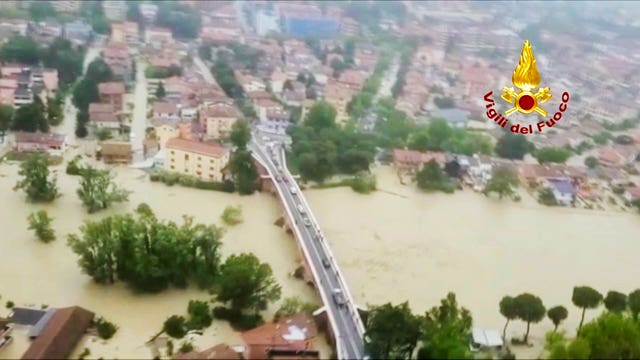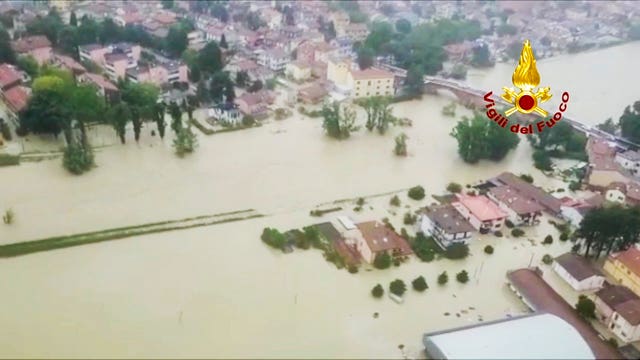Rivers swollen by days of downpours have flooded some towns in northern Italy, forcing residents on to rooftops, while in Venice, authorities are preparing to activate a mobile barrier in the lagoon in hopes of sparing the city from a rare May high-tide flooding.
After the Savio River overflowed its banks in the town of Cesena, in the heart of the Emilia-Romagna region, some residents of heavily flooded streets took to rooftops to await rescue by helicopters.
An older man died in his flooded home in the countryside outside of Cesena, while his wife managed to make it to safety, Italian state radio said early on Wednesday.
Some rescues were especially dramatic.

One rescuer held the child above the floodwaters until she could be passed into the arms of other rescuers.
Other residents helped the mother to safety.
Firefighters rescued a family with a four-month-old baby and a disabled man in the province of Pesaro-Urbino.
Elsewhere in the deluged north, parents and their two young daughters were plucked to safety by a firefighter helicopter, rescuers said.
The nearly 100,000 residents of the town were told to avoid the temptation to view the raging waters and not to stay on ground floors if they lived near the river.
“Use prudence, don’t be curious, so disaster doesn’t turn into tragedy,” mayor Enzo Lattuca said on Rai state TV.
In all, some 900 people in flooded areas of northern Italy were evacuated by late Tuesday night, some taking shelter in gyms or schools, the radio report said.

In Riccione, a beach town on the Adriatic Sea, the mayor warned people to stay home as some took to rubber dinghies to navigate streets.
In Venice, the barrier system, known by its acronym Moses, and recalling the Biblical account of the Red Sea parting, will be lifted on Tuesday night for the first time in May.
It is nearly 20 years since construction began on the project, which is still not officially completed.
Firefighters in Riccione, in the northern region of Emilia-Romagna, were deployed to rescue people from flooded homes and businesses.
By Tuesday afternoon, firefighters had carried out around 40 rescues in the province of Rimini, parts of which are on the Adriatic coast. Reinforcements were moved in from the cities of Forli’-Cesena, Ferrara and Bologna.
In the area between Ancona, a major Adriatic port, and Pesaro-Urbino, two towns popular with tourists, firefighters carried out 80 interventions for local flooding, fallen trees and mudslides and rescued motorists in difficulty, the corps said in a tweet.
In Modena, a small city famed for gastronomical products, authorities said they would close local bridges to traffic on Tuesday evening as a precaution against rising river levels.
In the town of Senigallia, the Misa River’s waters were receding, local officials said.

Train travel was halted on the Bologna-Ancona and the Ravenna-Faenza routes, Italian media said.
Earlier this month, a day and a half of non-stop rain caused flooding in the populous Emilia-Romagna region, leaving at least two people dead as riverbeds left dry by drought overflowed.
The rainfall came as Italy had been bracing for a second year of drought, which has depleted its largest river, the Po. The river supports agriculture in the vast Po River Valley before emptying into the Adriatic Sea east of Bologna.
While north-east Italy was hardest hit by the downpours, flooding also caused damage in the south.
On the island of Sicily, rescuers responded to flooding, fallen trees and other problems in the countryside between Palermo and Trapani. By Tuesday morning, the weather there was improving, firefighters said.






